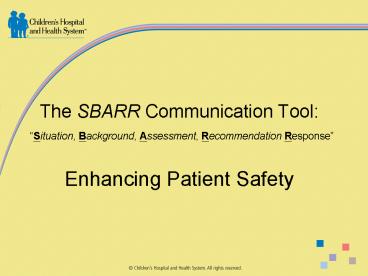The SBARR Communication Tool: Situation, Background, Assessment, Recommendation Response Enhancing P - PowerPoint PPT Presentation
1 / 17
Title:
The SBARR Communication Tool: Situation, Background, Assessment, Recommendation Response Enhancing P
Description:
'Situation, Background, Assessment, Recommendation Response' ... Situation: What is going on with the patient? ... Situation ... – PowerPoint PPT presentation
Number of Views:4370
Avg rating:3.0/5.0
Title: The SBARR Communication Tool: Situation, Background, Assessment, Recommendation Response Enhancing P
1
The SBARR Communication Tool Situation,
Background, Assessment, Recommendation
ResponseEnhancing Patient Safety
2
SBARR What is it?
- Situational briefing model that provides a
common, predictable structure to communication - Originally used in U.S. military and aviation
industry - Adapted for use in healthcare by Kaiser
Permanente in 2002 - Can be used in virtually any clinical setting
3
SBARR The basics
- Situation The problem
- What is going on with the patient?
- Background Brief, related, to the point
- What is the clinical background or context?
- Assessment What you found/think
- What do I think the problem is?
- Recommendation What you want
- What would I do to correct it?
- Response Receiver acknowledges information
given - What is the receivers response?
4
Overview of SBARRSituation, Background,
Assessment, Recommendation Response
- Communication challenges in health care
- Benefits of SBARR
- Practical application of SBARR
5
Communication Challenges
- Hand-off communication is a high-risk process.
- Communication failures commonly cause inadvertent
patient harm. - 60 -70 of the more than 2,455 sentinel events
reported to JCAHO revealed that communication
failure was the primary root cause--approximately
75 of these patients died. - CHW has had critical incidents related to
communication issues. - Standardization of hand-off communication is a
2006 NPSG. - (Leonard, Graham, Bonacum, 2004)
6
Barriers to effective communication
- Culture/Priorities
- Physicians vs. nurses
- Gender, cultural differences
- Complex, hierarchical systems
- Fear/intimidation
- Inhibits feeling safe to speak up hint/hope
approach - Environment
- Human factors/limitations
- Cultural norms
- Time
- No structured procedures
7
Effective Communication
- Complete
- Accurate
- Unambiguous
- Timely
- Understood
- Dialogue
8
Essential communication elements
- Being organized in thought and communication
- Being Competent technically and socially
- Disavowing Perfection while looking for
clarification/common understanding - Owned by the Entire Team this is not just a
subordinate skill-set - Valued by the receiver
9
Benefits of SBARR
- Teamwork
- Framework for effective communication
- Creation of a safe environment
- Framing a conversation, especially emergent ones
- Expectations
- Consistency, familiarity
- Critical Thinking Skills
- Sharing of relevant, timely, concise, organized,
efficient information - Patient Safety
- Reduces the risk of adverse events
- Fosters a culture of patient safety
10
Benefits of SBARRImportant elements
- Assertive communication
- Individuals speak up, state information with
persistence until there is a clear resolution - Helps create a shared understanding of what is
happening - Is crucial to patient safety
- Critical language
- Avoids natural tendency to speak indirectly and
deferentially - CUS words concerned, uncomfortable, unsafe,
safety, scared - Situational awareness
- Staff maintaining the big picture
- Ongoing dialogueplanning/thinking ahead
- Recognizing adverse events
- Common understanding of task
11
SBARR Example
- Situation What is going on with the patient?
- Dr. Jones, Im calling about Matthew, a 15 year
old-patient who was admitted for a closed head
injury after having fallen off a ladder
yesterday. He has developed new onset confusion
and restlessness. - Background What is the clinical background or
context? - Matthew was alert and oriented overnight. His
pupils were equal and briskly reactive. His GCS
was 14 and now it is 10. - Assessment What do I think the problem is?
- I am concerned that he may have a decreasing
level of consciousness.
12
SBARR Example (continued)
- Recommendation
- What would I do to address it?
- I would like you to come and assess this patient
in person - Response
- What is the receivers feedback?
- Thanks, this sounds like a significant change.
He may have edema or bleeding. Please do a set
of vital signs and I will be down to see him
right away.
13
Another Example
- Situation
- -Hello Sally(RCP), this is Mary, the nurse
caring for Jane Doe in room 678. She is an
asthmatic and is having increased respiratory
distress. - Background
- -Jane was admitted last night and put on the q 4
hour nebs per the respiratory protocol. It has
been 2 hours since her last neb and she has a
respiratory rate has gone from 30 to 50 with
increased retractions and more wheezing.
14
Example 2
- Assessment
- -I am uncomfortable with how she is doing. I
think she is having increased bronchospasm. - Recommendation
- -I would like you to come and assess her for
another nebulizer treatment right away.
15
Example 2
- Response(RCP)
- - I am finishing a treatment on 4 for a critical
patient. I can be there in 15 minutes. Do you
think the patient is stable enough to wait that
long? - Additional dialogue as needed
16
Final Thoughts
- SBARR can help CHW improve its communication so
that safe, quality patient care is delivered. - Using SBARR requires practice, teamwork, and
commitment from all CHW employees. - Initial focus/expectation is to use SBARR for CUS
(concerned, uncomfortable, safety) situations.
17
- Questions?































